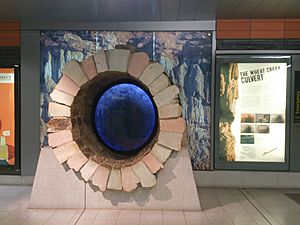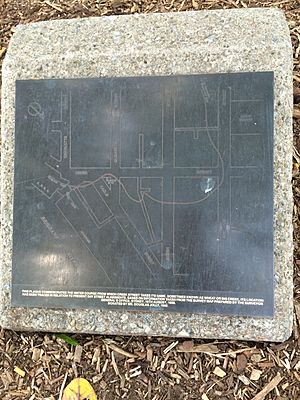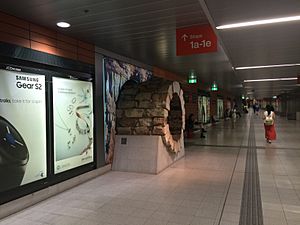Wheat Creek Culvert facts for kids
Quick facts for kids Wheat Creek Culvert |
|
|---|---|

Wheat Creek Culvert on display in the King George Square bus station
|
|
| Location | Adelaide Street, Brisbane City, Queensland, Australia |
| Design period | 1840s - 1860s (mid-19th century) |
| Built | 1861 |
| Architect | Christopher Porter |
|
Former Queensland Heritage Register
|
|
| Official name: Wheat Creek Culvert, Big Creek Culvert | |
| Type | state heritage (built, archaeological) |
| Designated | 24 January 2003 |
| Delisted | June 2015 |
| Reference no. | 602218 |
| Significant period | 1861 (fabric) 1860s (historical) |
| Builders | H C Love |
| Lua error in Module:Location_map at line 420: attempt to index field 'wikibase' (a nil value). | |
The Wheat Creek Culvert was an important old structure in Brisbane City, Queensland, Australia. It was like a tunnel built underground to carry water from a creek. This culvert was designed by Christopher Porter and built in 1861 by H C Love. It was also known as the Big Creek Culvert.
For many years, it was listed on the Queensland Heritage Register, which means it was considered a special historical site. However, in 2015, it was removed from the list because most of it was taken apart. This happened to make way for the Inner Northern Busway. Luckily, a small piece of the culvert was saved. You can now see it on display at the King George Square busway station.
Contents
Brisbane's Early Drainage System
The Wheat Creek Culvert was built in 1861. It was an early part of Brisbane's drainage system. This project was one of the first big engineering jobs for the new Brisbane Municipal Council.
In 1825, a penal settlement (a place for prisoners) was moved to Brisbane. This was because a good water source was found there. This source was Wheat Creek, also called 'Big Creek'. The creek started near where Brisbane Grammar School is today.
It flowed through areas that are now Roma Street railway yards. It also formed a lagoon (a shallow lake) between George and Roma Streets. The creek then went across where Adelaide and Albert Streets meet. Finally, it flowed into the river at the end of Creek Street. You can still see where the creek used to be in some laneways on Adelaide Street.
Early Bridges and Water Supply
The first bridge over Wheat Creek was built in 1827. It was for a track leading to a windmill on Spring Hill. This bridge was later replaced in 1861.
In the late 1820s, Captain Patrick Logan built an earth dam across the creek. Water from this dam was sent through pipes made of hollow logs. These pipes carried water to the soldiers' barracks and the Commandant's house. Prisoners used a treadmill to pump the water.
In 1859, a large water tank was built near the dam. This water system was used until 1866. That's when the new Enoggera Reservoir started supplying water to the town.
Challenges for the New Council
The city of Brisbane was officially formed on 7 September 1859. The area had many hills and swamps that were hard to drain. Rainwater would naturally flow into these swamps and lagoons, then into the river.
However, high tides often made much of the land impossible to cross when it rained. Because of this, providing good water and drainage was a very important task for the new city council.
How Drains Improved Over Time
Before the 1840s, towns used simple surface drains or covered drains. Surface drains made roads higher in the middle to let water run off. The simplest covered drains were "box drains," which had a flat bottom. These often got blocked.
"Circular" or "barrel drains" were also used but were expensive and not always effective. A big improvement came with "ovoid" or "egg-shaped" drains. John Phillips designed the first ovoid drain in the 1840s. He suggested having separate systems for rainwater and sewage. Ovoid drains were better because their shape helped water flow faster. This made them less likely to get blocked. At first, these drains were made of stone, but by the 1870s, cheaper brick was used.
The first drain in Brisbane was built in 1860. It was a stone ovoid drain on Albert Street.
Building the Wheat Creek Culvert
On January 24, 1861, the council asked for bids to build a culvert. This culvert would enclose Wheat Creek under the road. It would also have box drains for water to enter and exit. The design was by the new City Surveyor, Christopher Porter. H C Love's bid of £830 was accepted on February 4, 1861.
In 1863, a brick drain was laid from Edward Street to Eagle Street. But before 1875, not much was done for Brisbane's water and drainage. The Brisbane Drainage Act of 1875 gave the government more power over drainage and sewerage. William David Nisbet, an engineer, took charge of designing the city's drainage. His main focus was the creek area near Albert and Adelaide Streets.
In March 1877, an ovoid brick drain was finished on Adelaide Street. It joined the old culvert and is still used today. Nisbet also designed a brick stormwater system under Makerston Street. This system drained the Roma Street area into the Brisbane River. He suggested that all new drains should only be used for surface water.
The culvert and drainage system around the intersection worked until 2008. In 2000, the Brisbane City Council used a video camera to inspect the culvert.
In 2008, the culvert was taken apart for the Inner Northern Busway. A part of it was put back together and is now a display at the King George Square busway station. Because most of it was destroyed, it was removed from the Queensland Heritage Register in 2015.
What the Culvert Looked Like
Before it was moved, the Wheat Creek Culvert was under the intersection of Albert and Adelaide Street. It was covered by many layers of dirt and road.
The culvert was made of a type of stone called Brisbane Tuff, also known as porphyry. It looked very much like its original design. It was about 16 meters (about 52 feet) long. It was also about 1.35 meters (about 4.4 feet) high and 1.33 meters (about 4.3 feet) wide.
The stone blocks were between 500 and 700 mm (about 20-28 inches) long. They were about 150 mm (about 6 inches) high and up to 400-500 mm (about 16-20 inches) deep. There were 25 of these large stone blocks in the culvert.
Two smaller drains flowed into the culvert from Albert Street. One was about 450 x 450 mm (about 1.5 x 1.5 feet) square. The other was a box drain, about 800 x 500 mm (about 2.6 x 1.6 feet). An ovoid brick drain from Adelaide Street joined the culvert. This carried water to the Brisbane River.
When it was listed as heritage, people noted that the culvert's heavy weight helped hold it together. There was not much mortar (the cement-like mix) visible in the lower parts. However, some mortar patches could be seen in the upper parts. It was generally in good condition.
Why the Culvert Was Important
The Wheat Creek Culvert was listed on the Queensland Heritage Register on January 24, 2003. This means it was recognized for its special historical and cultural value.
A Look into Brisbane's Past
The Wheat Creek Culvert was one of the earliest engineering projects managed by the new Brisbane Municipal Council. It helps us understand how Brisbane developed its drainage system. Even though it's mostly gone, it shows us how the city grew.
A Rare Example of Early Engineering
This culvert, made of Brisbane Tuff stone, was a rare example of its kind. Stone ovoid drains were only built for a short time in the early 1860s. By the 1870s, most drains were made of cheaper brick. So, this culvert was special because it was made of stone.
Learning from the Past
By studying the culvert, we can learn more about how Brisbane's drainage system was built over time. It offers clues about the engineering challenges and solutions of the past.
A Great Example of Its Kind
The culvert was in good condition and looked much like its original design. This made it a great example of a Brisbane Tuff ovoid culvert from the 1860s.
Showing Clever Design
The Brisbane Tuff ovoid culvert was an important part of the city's stormwater drainage system from the 1860s and 1870s. It showed great technical skill for its time. The development of ovoid drains was a big step forward in making drainage systems work better.



